The name of the plant’s genus, Calathea, comes from the word “basket’, a Greek term referring to plants’ spacious flowers. Its perennials being famous for their bright and bold foliage. While favored as indoor plants, they are also suitable for both indoor settings and outdoor plantations.
The genus Calathea—characterized by boldly marked, oblong leaves in a dazzling array of colors—includes some of the most beautiful tropical plants in the world. They are often called ‘prayer plants’ because of their unique leaf movements: they raise and lower their leaves from day to night as part of their circadian
rhythm. This phenomenon is called nyctinasty. Scientists theorize that these movements are meant to follow the sun and catch as much light as possible– and essential trait for a forest-floor dwelling plant.
Native to Brazil and grown indoors year-round, calatheas are true tropicals in every sense of the word, gaining a reputation for being somewhat fussy about their growing conditions. However, once those conditions are maintained, these tropicals will thrive and grow rather quickly, often reaching a mature size of 1 to 2 feet tall in a year. In addition to being popular houseplants, calatheas can also be found planted outdoors in tropical environments like Hawaii or southern Florida.
Calathea Plant Profile
| Botanical name | Calathea |
| Other names | Zebra plant, rattlesnake plant, peacock plant, cathedral plant, prayer plant. |
| Height and growth rate | Calathea has a moderately fast growth rate when the plant is happy. It can reach maturity within a year, reaching a potential height of up to two feet before stopping growing. |
| Light | Needs indirect light. Direct sunlight can burn the leaves of this plant. |
| Watering | Calathea needs to be watered regularly, and to be kept moist but not soggy. |
| Soil | This plant needs slightly acidic soil, with a pH of around 6.5. |
| Temperature | For this tropical plant, it’s essential to maintain warmer temperatures. |
| Toxicity to pets | Non-toxic |
| Flower Color | Yellow, purple, white, pink |
There are more than 300 species of Calathea in the wild, boasting a huge variety of arresting leaf colours, leaf veins and patterns. Some of them even grow eye-catching tropical flowers. These are the most popular and commonly found versions kept as houseplants:
- Calathea Orbifolia
- Calathea Warscewiczii
- Calathea Makoyana
- Calathea Crocata
- Calathea Ornata
- Calathea Zebrina
- Calathea Lancifolia
- Calathea Rufibarba
- Calathea Roseopicta
- Calathea White Fusion
- Calathea Flamestar
- Calathea White Star
- Calathea Musaica
- Calathea Medallion
- Calathea Maui Queen
- Calathea marantifolia
- Calathea loeseneri
- Calathea Louisa
- Calathea fasciata
- Calathea ‘Freddie’
- Calathea ‘Misto’
- Calathea lutea
- Calathea elliptica
- Calathea albertii
- Calathea leopardina
Calathea Orbifolia

Orbifolia prayer plants are known for their striking leaves: oval-shaped and broad, exhibiting a predominantly green base with light green or silvery streaks. These streaks mimic the same patterns as a candy cane, making them look particularly unique. Calathea orbifolia grows up to 3 feet tall and 2 feet wide with each leaf growing up to 12 inches wide, making this one of the largest prayer plant species. The growth rate is moderate, and the plant will go through a period of dormancy in winter.
Calathea warscewiczii
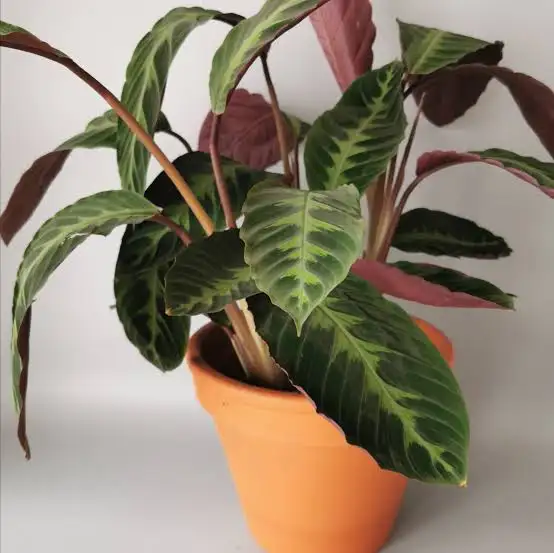
Calathea warscewiczii also known unofficially as Calathea Jungle Velvet, is one of the most remarkable varieties, sporting exotic velvety foliage with two-toned green tops and burgundy-colored undersides. Mature Warscewicziis are large houseplants that can grow to 3-4 feet high and wide in optimal conditions. Its soft velvety leaves feature a striking light-and-dark green fishtail pattern with solid purplish tones underneath. The plant may bear small cream-colored flower cones in season.
Calathea makoyana
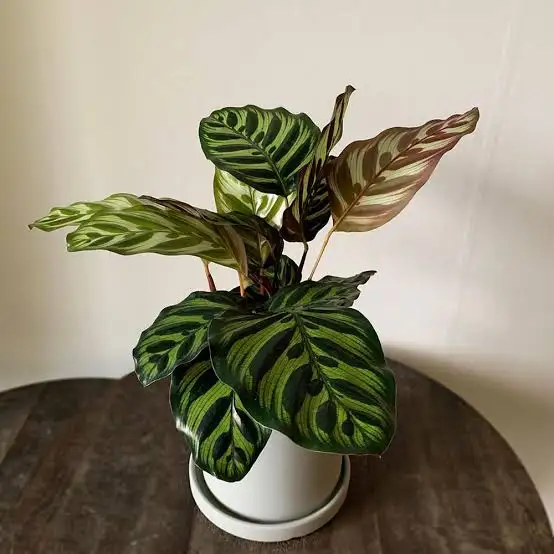
Calathea makoyana is an evergreen perennial that sports large, oval leaves on long, thin stems. These leaves sprout from a central rhizome and feature dark green blotches on a lighter green base. They really do remind me of peacock feathers, which explains how this prayer plant got its common name. The backs of the delicate, almost papery leaves are reddish-pink in color and look beautiful when the light shines through them.
Also Read: Different Varieties of Begonia For Your Home Garden
Calathea Crocata
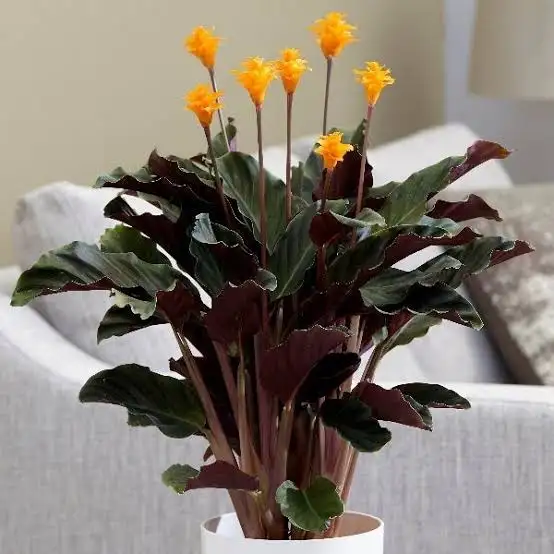
Commonly known as the ‘Eternal Flame’ due to its yellow and orange flowering stems, the Calathea Crocata is an attractive, tropical indoor houseplant. This variety has exotic, metallic green foliage with dark purple hues and brown undersides. During peak growth season, the vibrant flowers will last around 2-3 months and add that colourful feel to the inside of your house. In addition, this special plant will also inform you when its time for bed! The leaves will start to curl up at night before reappearing at the start of a new day. Keep the plant in partial shaded areas with some humidity.
Calathea ornata
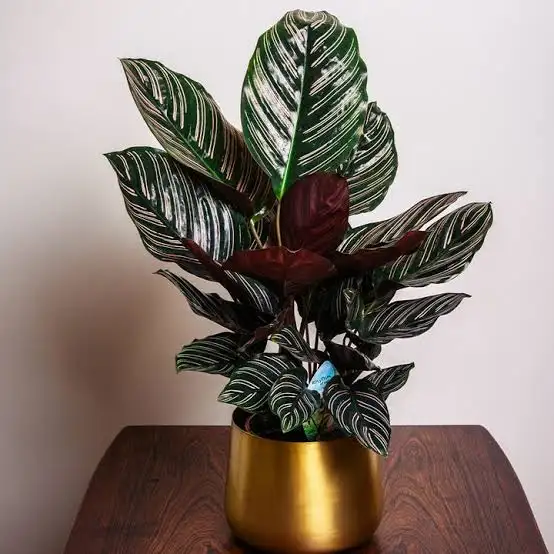
Calathea ornata is known for its striking patterned leaves. Dark green leaves are dashed evenly with pale pink stripes, and each leaf grows gracefully from the end of its own long stem. As an indoor houseplant, the Pinstripe Plant can grow up to 3 feet tall and 3 feet wide under proper conditions (it easily reaches 9 feet tall in the wild!). New leaves sprout from the center of the plant to form a dense, bushy growth. This houseplant grows upright and is actively growing from late spring through early fall.
Calathea Zebrina

Calathea Zebrina variety has velvety patterned ovate leaves which are light green in color with darker green stripes, like Zebra stripes. The underside of the leaves are purple and not always visible because leaves grow horizontally (although some will curve or grow more upright). It’s a clump forming plant that produces long stalks (up to 1 metre tall) and the leaves (15 inches or more in length) sit at the top. The Zebra plant produces purple or white inconspicuous flowers which are unlikely to appear indoors.
Calathea Lancifolia
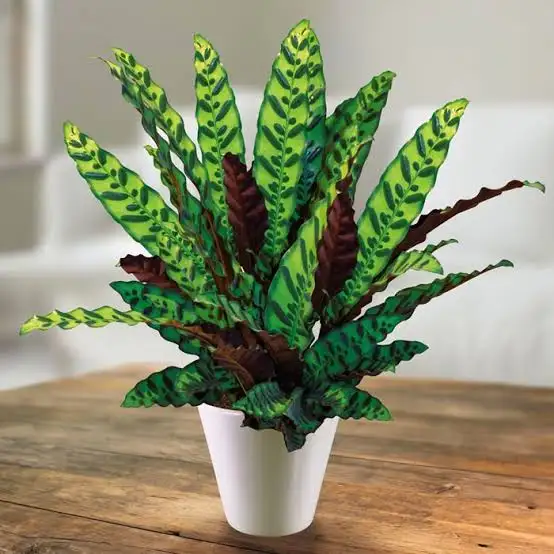
Calathea lancifolia has upright, lance-shaped leaves with long wavy edges that form in clumps, spreading slowly over time. The leaves are variegated with dark green strokes on a pale green background. The undersides are a burgundy red and velvety to the touch. This Rattlesnake plant is also sometimes known as Calathea insignis. Its bushy, compact growth habit makes it ideal as a medium sized floor plant or tabletop accent and anywhere that needs a little extra green and a tropical feel.
Also Read: Different Varieties of Alocasia Plants
Calathea rufibarba
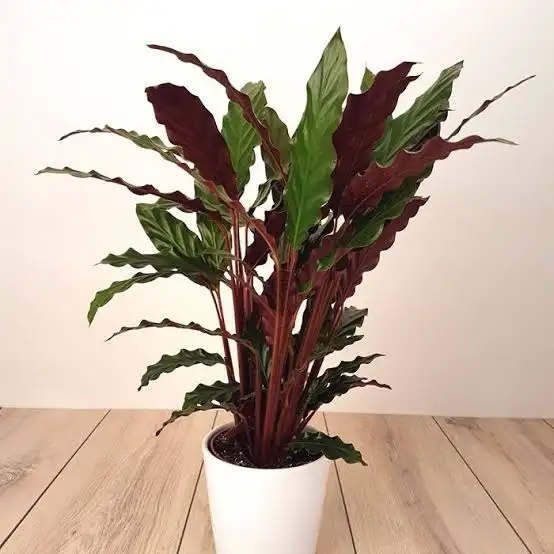
Calathea ‘Furry Feather’, or Calathea rufibarba, is a herbaceous plant with long leaves, which have very distinctive ruffled, or wavy edges and velvety red undersides, and which are held almost upright (making the undersides visible). This plant gets its common name, Velvet Calathea, from the fuzzy texture of the underside of its leaves. This has led many gardeners to give it nicknames such as “the fuzzy/ furry feather Calathea,” “velvet Calathea,” “furry Calathea,” and many more.
Calathea Roseopicta

Rose painted calathea also referred to as Calathea Roseopicta has green elliptic leaves that display pinkish colored stripes from the midrib. The midrib is also pinkish in color, although this and the stripes will turn white when the plant matures. These leaves fold up slightly when night time arrives which gives a grower the additional feeling of the plant being alive. The leaves grow at the top of the stalks and reach up to 30 inches tall. Calathea roseopicta will bloom during the summer with small white and purple flowers which are non-showy, but still nice to see.
Calathea Fusion White
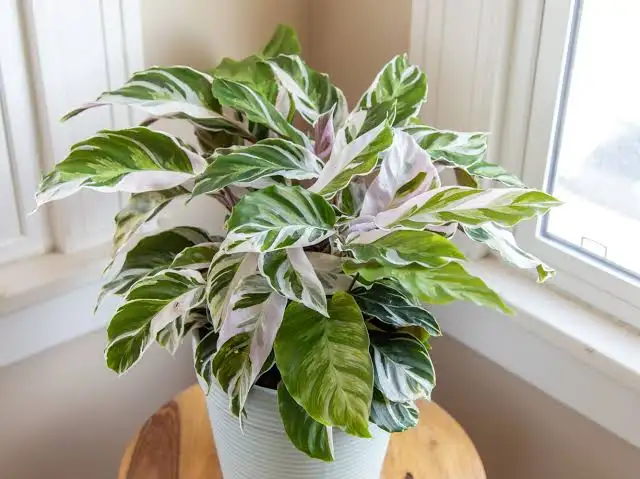
Calathea ‘Fusion White’ has recently been reclassified, it is now known as Goeppertia lietzei ‘Fusion White’. This species is a tender evergreen perennial that produces attractive variegated white and green leaves. It typically grows to around 60cm tall and is best propagated through division. It forms clumps of long, narrow, lance-shaped, variegated leaves with purple undersides. The leaves can be green, light green and white, the patterning is often patchy and marbled. The leaves measure up to 45cm in length. Yellow flowers can be produced in summer, but this infrequently occurs when grown indoors as a houseplant.
Also Read: Different Types of Hoya Plants
Calathea Flamestar

The Calathea Flamestar is an indoor plant that many plant lovers appreciate for its stunning, evergreen leaves. They are coloured in shades of both light and dark green, with the overall finish of each leaf providing a real sense of class and trendiness. The Prayer Plant, as its more commonly known, is one that will benefit the atmosphere around it by purifying the air. It will remove harmful pollutants and unwanted toxins from the air, dispersing fresh oxygen back into the area around the plant.
Calathea White Star
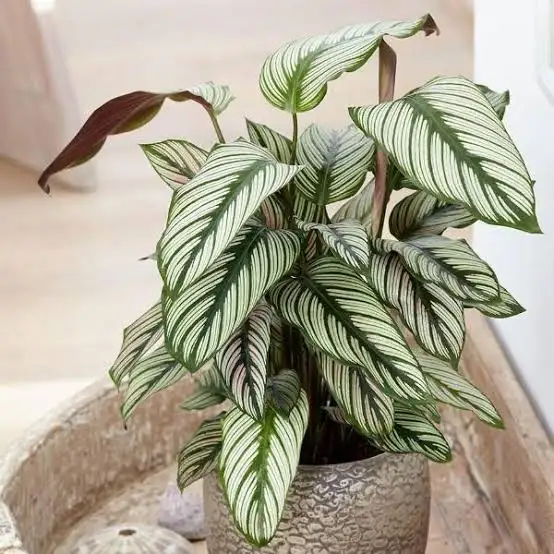
The Calathea White Star is also known as Calathea Majestic, White Star Calathea, and Majestic Prayer Plant.This specimen is known to be a cultivar of the ornata species and sports several bright white stripes from the midrib of the plant extending to its leaf blades. Some of the leaves may feature pink shades near the midrib, depending on the light conditions and maturity of the plant. It also resembles the Vittata variety. Given proper care, this plant can grow as high as 4 to 5ft in large pots and the leaves can become very long.
Calathea musaica

The name Calathea musaica is used commonly in the houseplant trade, as are the names Calathea ‘Network’ and Network Prayer Plant. With mid-green, gently arching, slightly glossy leaves patterned with the most interesting and beautiful criss-cross, or mosaic pattern, it’s not hard to see why the common name “Network” was coined. Musaica plants grow from rhizomes. They have a slow growth rate and reach 2” tall and 2” – 3” wide at maturity. When you care for your Calathea musaica plants correctly, you can enjoy their beauty for years. Improper care can shorten their lifespan.
Also Read: Difference Types of Anthurium Plants
Calathea Medallion
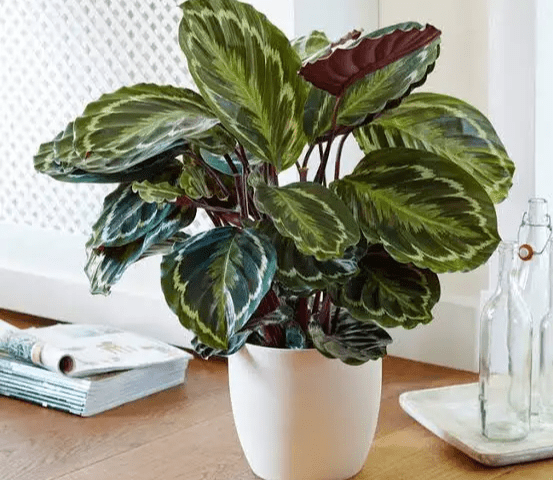
Also referred to as Calathea veitchiana, this plant has large, light-to-dark green medallion-like leaves with deep burgundy undersides. In the evenings, the calathea medallion leaves fold up slightly, similar to the prayer plant. The large oval leaves of the calathea medallion sprout from a single stem that grows about two to three feet in height. Calathea veitchiana medallions have a slow growth habit, and the best way to propagate them is to divide their tuberous roots (called rhizomes) and replant them. These plants thrive in medium to low light making them suitable for either the home or office.
Maui Queen Calathea
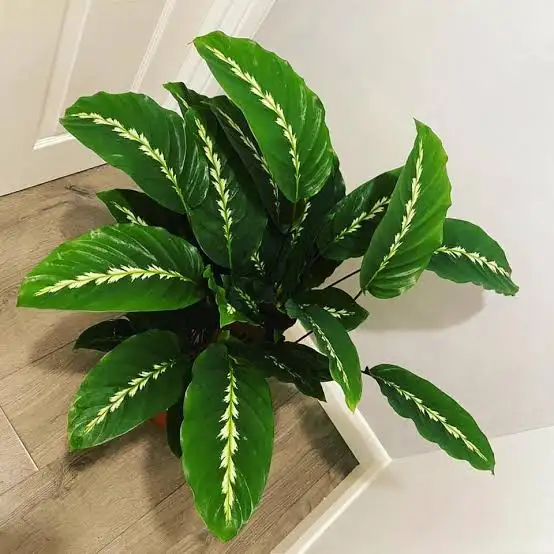
Calathea Maui Queen is a rare tropical plant that is actually a hybrid cultivar of two Calathea species. It has spectacular foliage of three shades, green leaves with white-stroked centers, and purple undersides. This plant perfectly lifts up any plant collection and adds a tropical jungle look indoors. This pattern looks hand
painted like a nature-made brush stroke.
Calathea marantifolia
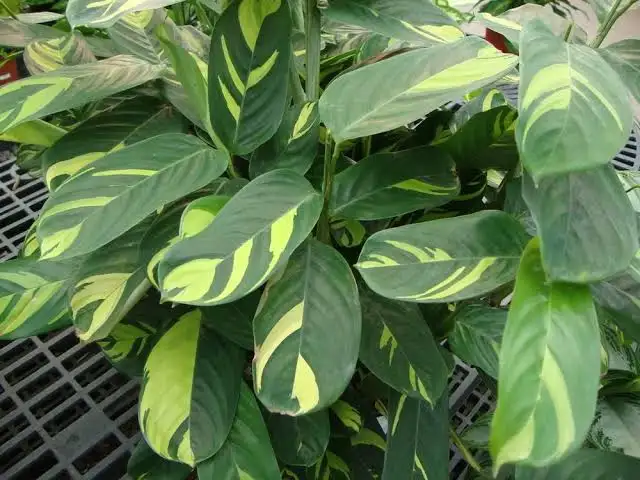
This one is a beautiful, banana-like variety from the Marantaceae family. This Calathea variety has enormous, broad, narrow stalked foliage that can reach 39 inches. It bears greenish inflorescences with bright yellow blooms.
Calathea Loeseneri

Calathea Loeseneri is a fabulously large Calathea with elongated oval-shaped green foliage having light green colored midrib, increasing the leaves’ allure. A long erect petiole attaches foliage that is not patterned, contrary to other Calatheas. However, its beautiful star-shaped flower is the feature that makes it an eyecatcher for plant lovers. The blooms consist of white to pinkish lance-shaped petals on a long delicate stalk, which will bring a lot of grace to your garden.
Also Read: House Plants That Are Safe To Dogs And Cats
Calathea Louisa
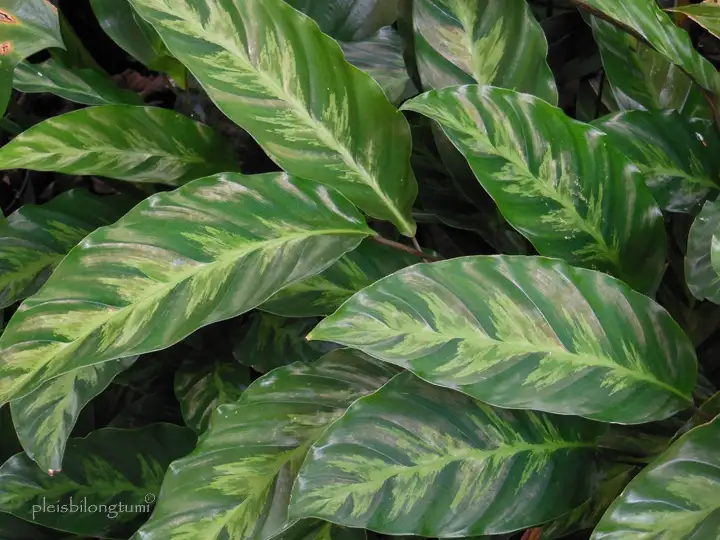
Also known as the Calathea Thai Beauty, the Calathea Louisa is an extremely attractive houseplant with vibrant yellow and deep green stripes on one side and a gorgeous purple underside. The plants will grow to around 2.5 feet high and produce leaves that can grow to between 6 to 9 inches long. One of the reasons the Calathea louisae is easy to care for is that it is well-suited to indoor conditions. It enjoys bright, indirect light. But, will do quite well in both medium and low light.
Calathea fasciata

Calathea fasciata is a beautiful foliage plant with strikingly attractive leaves. With its large, round, thick leaves with alternating shades of deep green and grass green. Also, prominent veins along with purple underside is a dream come true for foliage lovers. The pleasant to the eyes stripes with a blend of equally soothing shades is a unique indoor plant that cannot be left unnoticed. The luscious leaves with the pattern of a healthy plant are shiny and make the interior come to life.
Calathea Misto
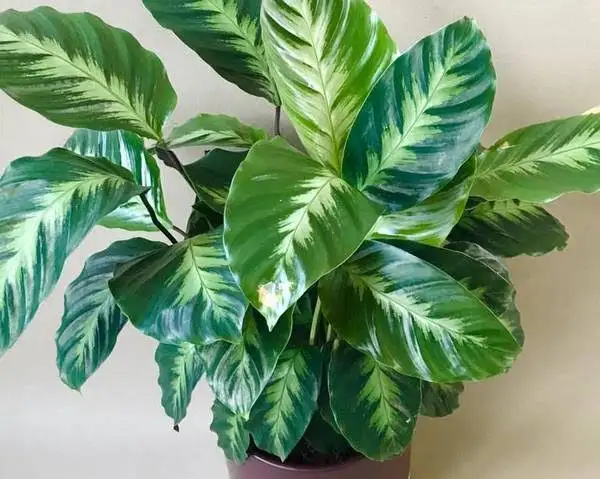
Goeppertia ‘Misto’ has undergone extensive reclassification, but is well known by the name Calathea ‘Misto’. More often, it’s called Prayer Plant ‘Misto’ after the fantastic foliage. Calathea ‘Misto’ has large, glossy, slightly ruffled leaves in medium green with a thick, pale green feather pattern down the center and deep purple undersides.
Calathea Freddie

The Calathea concinna known as the Calathea Freddie is among the Prayer Plant Calatheas, which spread their leaves with the sunrise to absorb the sun. With its elongated shiny leaves, sporting beautiful zebra stripes in shades of green, Calathea Freddie will liven up your home like no other plant. The Freddie is perfect for bright indoor spaces and both for tabletop and floor planters.
Calathea lutea

Calathea Lutea is a unique plant in the Calathea family with large dark green, paddle-shaped leaves. The plant is different from low-laying family members as it grows pretty tall, around ten to twelve feet. The paddle-shaped leaves extending from individual stem makes the plant a perfect choice to beautify your garden corners. Calathea Lutea is also famous for the Havana Cigar plant and Cigar Calathea because of the cigar-like flowers. It is a popular, easy-to-care for household plant. It has broad leaves and produces waxy red flowers. It prefers indirect lighting, and will grow best in a shady room.
Calathea vittata
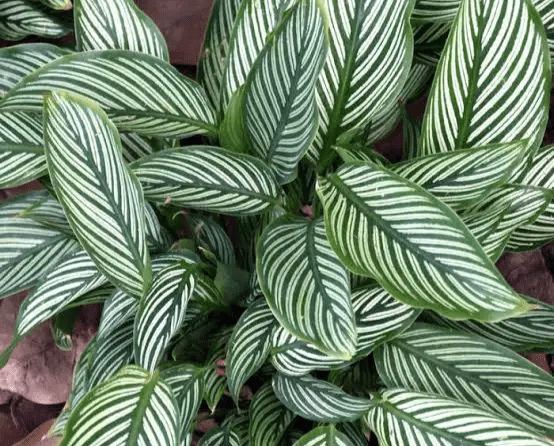
Calathea vittata also referred to as Calathea elliptica is a stunning plant with beautiful oversized leaves that feature white variegation on a green background that genuinely stands out. The blossoms have a light cream color to them. This plant is smaller than the others of its kind, growing to a height of 24-26 inches. The plant is fairly short reaching only 12 inches tall. This makes it perfect for tabletops or as living room décor.
Also Read: Different Types of Sage Plants
Calathea albertii

Calathea albertii is a dwarf, rhizomatous, clumping perennial that is grown for it’s striking foliage. Leaves are shiny, dark green and can be around 15 cms long with contrasting pale green feather-like stripes on them – being purple to red on the undersides.These are warm climate plants where they go well under taller plants in their dappled shade or they will grow well also as indoor plants in cooler climates. They produce short spikes in summer carrying white flowers.
Calathea leopardina
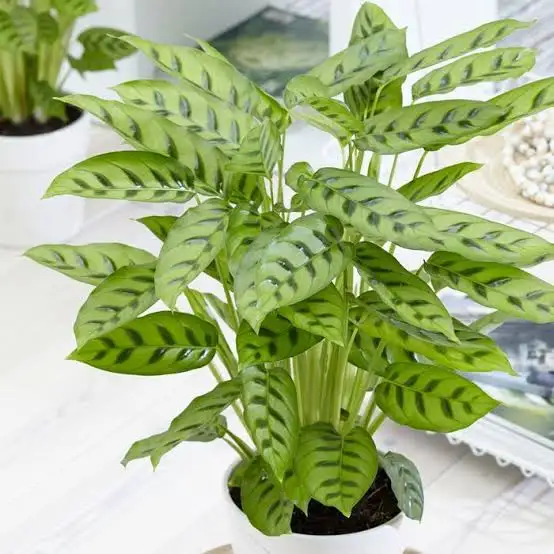
Calathea leopardina, often called Shadow Plant, is an elegant plant that offers a great tropical display. Translucent bright green leaves with deeper green patterned markings, reminiscent of an animal print, stand out from the plant on strong upright stems creating a well-shaped pretty plant. The leaves attach to long, vertical stems that spread outwards in random directions giving a mystical display in any area of your house, whether it is a corner, garden, etc. It’s worth mentioning that taking care of it is just like squeezing a lemon, making it one of the greatest Calatheas for gardeners.